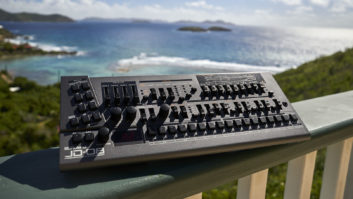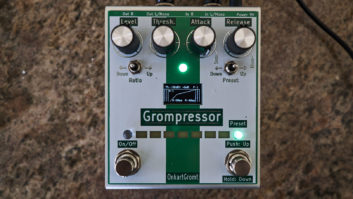I own many older TASCAM units, but had not seen much—other than a few film sound products—that interested me over the last decade. That changed with the DA-6400; I am incredibly excited about it!
The DA-6400 has the capability of being outfitted with various I/O cards and, of course, I chose the Dante card. 64 channels of high-definition audio via one Cat 5 cable? Why yes, please!
In my last article for Pro Sound News, I experimented with recording from my Allen & Heath GLD80 to my Pro Tools rig via the Dante expansion I/O card to my laptop. In doing so, I had to use the Bel Digital BM-A1-64Dante to be able to monitor individual channels. The TASCAM is a sleek 1U rackmount recording device that utilizes a small (in physical size only) SSD that lives in a chassis. With it, users can hot swap and connect via USB 3.0 for transferring of files—very efficient!
Equipped with the typical features we have all grown to love from TASCAM and a fairly easy menu navigation, I was up and running with this bad boy in a very short amount of time. The small screen on the front provides the option to monitor all 64 channels or a smaller selection, if desired.
I used the TASCAM DA-6400 with the Winston-Salem Symphony during its Cirque de la Symphonie concert. I was running live sound for the performance and had 28 microphones on stage placed for sound reinforcement purposes and six monitors and two front fills. I chose to tap into the mics I had set rather than putting mics up specifically for recording on this show. My mistake (or limitation, perhaps) was that I pulled the signal directly from the RIOs instead of pulling from the post fader of the console. Typically, that is how I would run a recording, in pre-fader. However, I discovered that I really wanted to hear the sounds of what I produced in the house, including compression and EQ. This was impossible to tell with the recording I had straight from the preamps. The mix from the recording ended up being its own blend. An interesting thought is wondering where the Dante routing cuts from the signal flow chain; even if I routed the Dante channels from the Yamaha CL5, I was unsure at what point I was getting the signal. In analog days, we would route via aux and choose whether we wanted it to be pre-fader or post-fader.
Another interesting bump I ran into was that when I run sound in the house, I move the CL5 to a satellite location in order to hear better. That location is equipped with a primary and secondary network, but no switches. When trying to hook up multiple pieces of equipment to the two dedicated networks, users need a switch on each network. I was wary to rely on just the primary network alone, as the packets of information seem to have a little trouble staying in sync with each other. I was concerned for latency as well.
The price point for the TASCAM is up there (at $3,499 street). However, for its compact physical size, huge information capacity and the flexibility to create a simple recording system that, if combined with proper switches, could easily pop into any Dante network for multi-track capability, I think it is money well-spent. I see this as a preferable option for Dante recording compared to using my laptop with Pro Tools as long as you have a system of preamps to pull from.
I will be using the TASCAM again this very weekend for a full ensemble band recording and am pairing it with my Allen & Heath console. I think this will be my best use of the DA-6400 yet.







